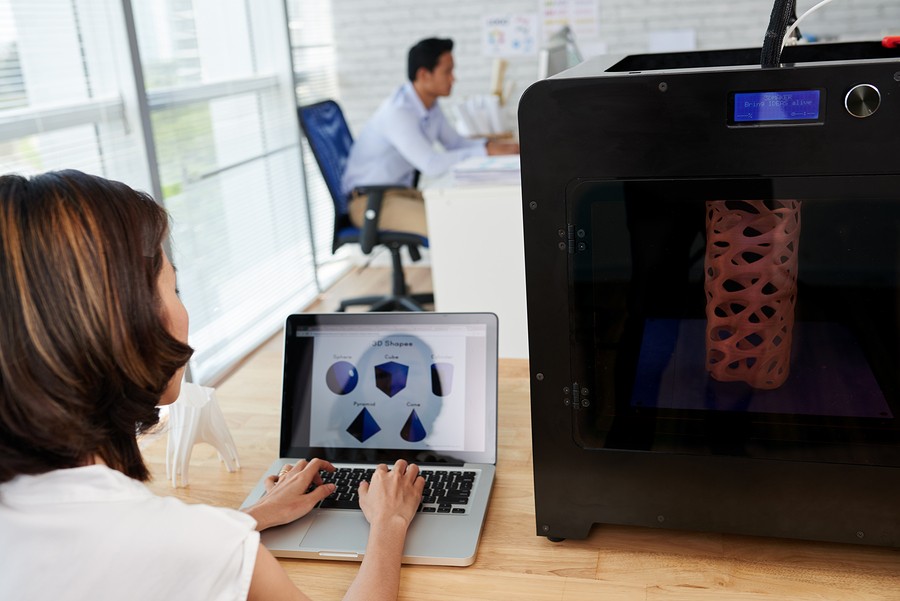Who Owns Intellectual Property in Manufacturing?

As additive manufacturing continues to grow in popularity and usefulness for manufacturers, an issue surrounding it begins to arise. Manufacturers and consumers alike are adopting the technology, but when it comes to who owns the designs and who can use them, 3-D printing waters begin to get murky. This is especially true for manufacturers who design and print proprietary products as those wanting to get their hands on said designs must either remake them from scratch — or steal them. So, who owns additive manufacturing intellectual property?
Production change
 While in the past parts were the objects of value, additive manufacturing has upset this ownership balance by shifting value focus to designs. Now, rather than purchasing parts and products, those with 3-D printers can create them in the comfort of their homes. This, of course, brings about questions of ownership and quality.
While in the past parts were the objects of value, additive manufacturing has upset this ownership balance by shifting value focus to designs. Now, rather than purchasing parts and products, those with 3-D printers can create them in the comfort of their homes. This, of course, brings about questions of ownership and quality.
Individuals with 3-D printers can produce products with relative ease almost anywhere. But the designs they use aren’t always purchased — and production and finished products aren’t maintained under the same quality and safety standards manufacturers adhere to. Why? Cost plays a major factor, as these do-it-yourself printers can often produce parts at a fraction of the cost compared to manufacturers. Without industry safeguards and consistent printer calibration, end-users might not quite be getting what they bargained for.
The problem is compounded by the ability to scan manufactured products and re-create them at home. So, even if individuals own products, they may have stolen the designs, undermining the original designers, engineers, or manufacturers. Not only can this hurt manufacturers but it can also damage their brands — especially in cases in which these at-home producers improperly use manufacturers’ brand names when selling DIY printed products.
Ownership
 In such a rapidly changing industry, intellectual property laws are inherently difficult to enforce. This is especially true when individuals can create computer-aided design (CAD) files of products and widely distribute them to others who can print using them. In addition, those who receive the files can change them as they see fit. With changes made to the original, owners of these slight redesigns can then patent their creations, adding to the issue. On top of that, those who do sell completed copyrighted files to clients may find it difficult to prohibit their clients from re-selling the files to others or giving them away for free, further taking ownership away from the original designers.
In such a rapidly changing industry, intellectual property laws are inherently difficult to enforce. This is especially true when individuals can create computer-aided design (CAD) files of products and widely distribute them to others who can print using them. In addition, those who receive the files can change them as they see fit. With changes made to the original, owners of these slight redesigns can then patent their creations, adding to the issue. On top of that, those who do sell completed copyrighted files to clients may find it difficult to prohibit their clients from re-selling the files to others or giving them away for free, further taking ownership away from the original designers.
China
One example of intellectual property use in manufacturing comes from China. In fact, per trade agreements, some American companies are required to share intellectual property with Chinese manufacturers as part of U.S. access to the Chinese economy. This means many American manufacturing firms must partner or otherwise share technology and resources with Chinese manufacturers. While this increases product availability, it also reduces exclusivity for made-in-America products as Chinese producers can legally make the same products — and, in many cases, at lower costs.
Those who say this “stifles U.S. economic growth” might not be wrong, as “losses stemming from it could total hundreds of billions of dollars annually that cost the U.S. economy millions of jobs.” How could the forced sharing have already totaled so much? It’s based on the Trade Act of 1974, a long-standing agreement. But President Trump signed a memorandum in mid-August calling for an investigation of Chinese practices that might “be unreasonable or discriminatory and that may be harming American intellectual property, innovation, and technology.”
Will American designers, engineers, and manufacturers see more protections in the future when it comes to their intellectual property? From proliferation of files to counterfeit products, the fight against intellectual property might only just be beginning — and only time will tell who will win.